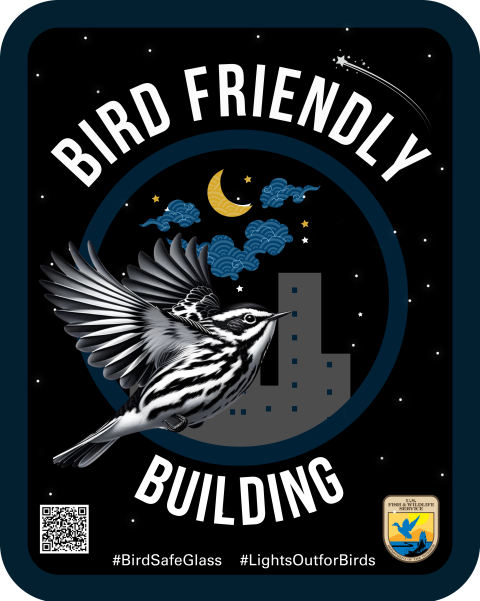About this Collection
Every year, more than 1 billion birds are killed from colliding with glass in the United States. Almost half of these collisions occur at low-rise buildings with reflective glass windows and doors, where birds struggle to see the glass and fly towards the mirrored appearance of natural habitat like plants and sky. While most of these window collisions happen during the day, it also happens at night when birds are attracted in towards light shining out of windows from the inside or light shining towards windows from the outside. While some birds might seem fine after a collision, most eventually die later from injuries.
Witnessing such events can be very upsetting, but the good news is: there are actions you can take to help prevent these fatal collisions!
Do you hear or see birds hitting windows or glass at your building or facility?
If it has happened before, it could happen again!
- Keep close attention to where and when birds collide at your facility so you can identify the windows or areas to prioritize. Bird carcasses, feather prints and feathers stuck to glass are good indications of collision problems and reasons to retrofit glass. If necessary, you could even start a Bird-Glass Collision Monitoring Program with your colleagues! However, all glass has the potential to cause bird collisions, even small windows and interior atriums, and monitoring requires time and costs which could otherwise be allocated to glass retrofits and collision prevention. Sometimes collision monitoring can cost more time and money than retrofitting the glass and preventing collisions.
- Make the glass at your building more visible to birds by adding one of the many product options on the exterior with 2-inch by 2-inch spacing. You can check the effectiveness of treatment options in American Bird Conservancy’s Products & Solutions Database.
- For new construction or remodeling, choose bird safe glass, like patterned, frosted, acid-etched, fritted, and stained glass. These attractive options allow natural lighting and (like other collision reduction products) increase both bird safety AND energy efficiency. A win-win scenario!
At night, do indoor lights shine out your windows or do outside lights shine in your windows?
Birds are attracted to lights at night, which often steers them off their path, causing them to become disoriented, exhausted, and more likely to collide with windows or other lit structures.
You can help prevent the threat of light pollution by simply turning off or minimizing lights at night and by closing curtains or blinds to keep outside lights from reflecting in or out of windows. These actions are most important at night between 10pm- 4am, when most birds are often on the move during their migration. In the contiguous US, nocturnal birds migrate in spring from mid March to mid June, with the greatest numbers of birds passing through from mid-April to mid May. In autumn, nocturnal migratory birds are on the move from mid August to mid November, with the peak period occurring in early September through October. For more specific information about bird migration in your area, check out the BirdCast nightly movement forecasts with real-time live migration maps.
If outside lighting is necessary, you can still help by choosing…
- Down shielding lights
- Motion sensors and timers
- “Warmer” amber light rather than “cooler” blue or white light
Is there a bird feeder or water source near your glass windows?
While most people enjoy attracting birds with bird feeders and water sources, these attractants can actually put birds more at risk by bringing them in closer to glass, lights at night, and other threats like predators.
What can you do?
- Keep bird feeders and water sources within 3 feet of glass to prevent them from gaining enough momentum for fatal collisions.
- Prioritize lights out and glass treatments in areas nearest to bird attractants.
Why stop there? Make conservation a part of your brand and spread awareness in your community so more people get involved. Let’s make bird conservation a social norm!
Educate building and facility employees, tenants, and/or customers on the positive changes you made and why.
Inspire others on social media with #BirdSafeGlass, #BirdFriendly, #BringBirdsBack, #SafeSkies, and #LightsOutforBirds!
We can amplify our bird conservation efforts by increasing awareness and action within our communities. Let’s make bird conservation a social norm.

